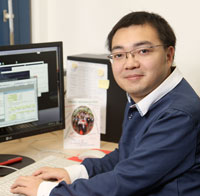| Posted: Jan 22, 2018 | |
Two dimensional circuit with magnetic quasi-particles(Nanowerk News) Whether smart phone, computer or dialysis machine – there is no electronic device without chips and their electronic components inside. The individual circuit elements are therefore often wired using three dimensional so called bridge constructions. |
|
| Currently, physicists at Technische Universität Kaiserslautern (TUK) are working on a more efficient variation, where specific quasiparticles named magnons instead of electrons are being used. They have shown for the first time, in an initial model, that magnon current flow is possible in an integrated magnon circuit, in which case the components are only being connected two dimensionally. These investigations have been published in Science Advances ("Reconfigurable nanoscale spin-wave directional coupler"). | |
| A technical revolution came when the US engineer Jack Kilby developed the integrated circuit in the 1960s. Initially assembled in a pocket calculator, this technology enabled the triumph of the computer shortly thereafter, which from that point on came with smaller and smaller processors. | |
| “These circuits then set the stage for today’s consumer electronics” according to Associate Professor Andrii Chumak, who is a researcher with his own sub-group in the Magnetism Research Group lead by Professor Burkard Hillebrands in Department of Physics at TUK. Kilby was awarded the Nobel prize for Physics in the year 2000 and is now referred to as the father of microchips. | |
 Lead author Qi Wang In a current study, the lead author Qi Wang who is Dr. Chumak’s PhD student is working on a new generation of circuits. “Information can be transported in the form of intrinsic angular momentum” continues Chumak. “These quantum particles are magnons.” They can transport significantly more information when compared to electrons and require substantially less energy, as well as produce less wasted heat. This makes them rather interesting, for example for faster and more efficient computers, particularly in mobile applications. In the now published study, the scientists have for the first time described the so called magnon integrated circuit in which information is carried by way of these particles. In this case, conductors and line crossings are necessary to connect the individual switching elements, as in the case of electronic circuits. The researchers have managed to develop such a junction for magnons in their simulations. “We have managed to include this phenomenon into our calculations which is already well-known in physics and will be placed into application for the first time in magnonics” according to Qi Wang. “When two magnon conductors are placed rather closely together, the waves communicate to a certain point with each other, this means, that the energy of the waves will be transferred from one conductor to the next.” This has been used in optics applications for quite some time, for example for the transportation of information between optical fibers. |
|
| The sub-group of Professor Hillebrands' Magnetism Group, the "Nano-Magnonic" team lead by Chumak, have harnessed this method for the wiring of circuit elements on a magnonic chip in a novel way. What is so special in these new simulated results, is that they can be used for junctions without any three dimensional bridge construction. This is necessary in classical electronics to guarantee the flow of electrons between several elements. | |
| “In our circuits we use two dimensional connections, in which the magnon conductors only need to be placed close enough to each other” says Qi Wang. This connection point is referred to as a directional coupler. The researchers now intend to layout the first magnonic circuit with the help of this model. | |
| For a future production of computer components these novel circuits could contribute significantly to saving material and, therefore, cost. In addition to that the size of the simulated components are within the nanometer regime, which is comparable to modern electronic components; however, the information density using magnons is significantly greater. |
| Source: Technische Universität Kaiserslautern |
